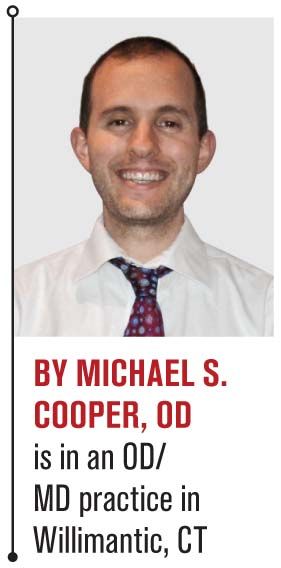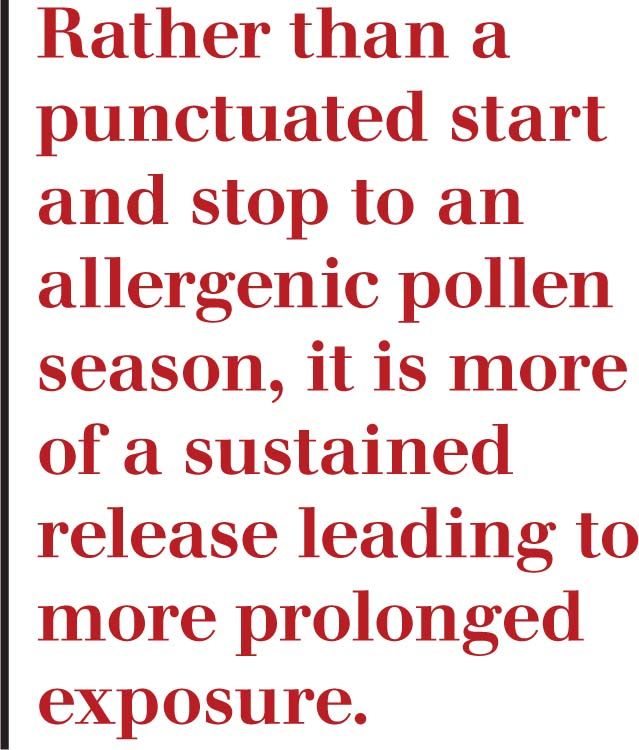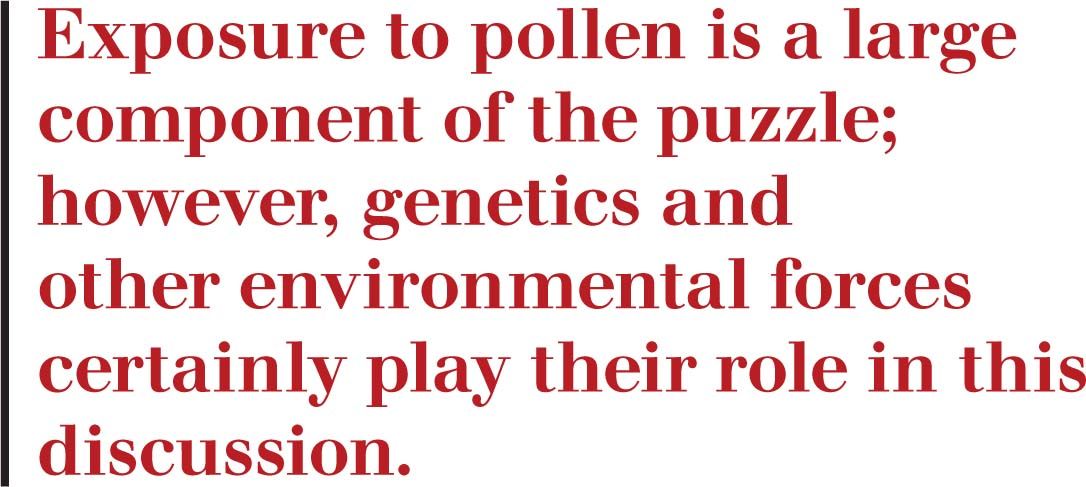The increasing role of climate, hygiene, and aerobiology in allergy
With Earth’s climate change, both higher temperature and carbon dioxide levels have been inducing vigorous amounts of allergen production from multiple plant and tree species blooming faster than expected for at least the past 160 years.

Although the winter doldrums and mammoth snowstorms in the Northeast would tell you otherwise, spring is actually around the corner. With Earth’s climate change, both higher temperature and carbon dioxide levels have been inducing vigorous amounts of allergen production from multiple plant and tree species blooming faster than expected for at least the past 160 years. In fact, famed naturalists Henry David Thoreau and Aldo Leopold began carefully recording temperature and bloom data which corroborated the correlation to pollen production without the need for expensive instrumentation.1 A perfect example is found within Thoreau’s writings in 1853 in which the highbush blueberry has accelerated its flowering habit approximately six weeks earlier as of 2012.1
The wibbly-wobbly pollen flux
Historically, the common thought is that allergy season has a May to August schedule. However, Singh et al illustrated it is actually a year-round phenomenon with known spikes in April/May and August/September.2
What does this mean for all of us?

Rather than a punctuated start and stop to an allergenic pollen season, it is more of a sustained release leading to more prolonged exposure. Consequently, depending on geography, pollen will be upon us soon and will be more impactful not only to our environment, but to our symptomatic patients whether they are new or returning to our practices.
A word of warning: we are all living through the climate fluctuations which leads to nonlinear short-term peaks and troughs with regard to allergy patient population year after year.
Related: 3 tips to navigate the allergy discussion with kids
Over the past five years, my practice in Connecticut performed a small data study capturing allergy coding which confirms an increase in the number of patients seen for allergic conjunctivitis.
A further assessment of follow-up and medication prescriptions from initial presentation also demonstrated that these cases have become more ferocious to treat beyond the simplistic allergy drop. In many cases, a documented allergist and/or ear, nose, and throat specialist referral was necessary to provide systemic stability.
Next: Hygiene hypothesis
Hygiene hypothesis
A majority of the literature and dissemination in the media has been focused on the hygiene hypothesis with respect to the overuse of antibacterial soaps, air-tight doors, and vaccinations to reduce exposure to the world of microbial biota.3-5
Related: What's trending in ocular allergy treatment
Studies dating back to the 1950s show that industrialized nations have successfully lowered the infectious disease burden but have raised the risk level for allergic and autoimmune disease.6 Furthermore, there is a current notion for which some infectious agents-remarkably those genetically co-evolving with us-are able to protect against a large spectrum of immune-related disorders such as type 1 diabetes and multiple sclerosis.6
Next: Aerobiology
Aerobiology
Within this sterile realm, there is a subset of knowledge quickly developing in almost a vacuum-like state referred to as aerobiology-the science of airborne particulates of organic origin. More children stay indoors due to increased digital device use and rarely venture into the outside world, causing an increased ocular and asthma sensitization to pollen and fungal agents.7 Additionally, there is a prevailing thought process in that, when outdoors, young children of smaller stature are further exposed to pollen because the granules floating through the air will disperse lower to the ground by sheer weight.
Both the research and clinical community have recognized that pollen and air pollution dispersion are at times inconsistent with weather patterns and vary around the globe.8 Filling this space is an emerging concept in the literature based on molecular allergology for which links each patient’s immunoglobulin (Ig) E antibody profile to individual allergenic pollen components.8
Consequently, the ability to discriminate between genuine sensitization to certain specific allergen sources and cross-reactivity will ultimately improve and lead to more efficient epidemiological management and treatment of allergic conjunctivitis and rhinitis.9-12
Next: It's not just one thing

It’s not just one thing
It would be amazing if each allergy case seen was straightforward, but it is not. The concern at hand is that ocular allergies share the same common intrinsic and extrinsic story thread with dry eye disease.
Exposure to pollen is a large component of the puzzle; however, genetics and other environmental forces certainly play their roles in this discussion. My final sentiment is quite elementary: take a step back for a moment in order to look at the forest, not just the trees.
Related: Nonpharmocologic care for ocular allergies
References:
1. Primack, RB. Walden Warming: Climate Change Comes to Thoreau's Woods. Chicago: U of Chicago, 2014.
2. Singh K, Axelrod S, Bielory L. The epidemiology of ocular and nasal allergy in the United States, 1988-1994. J Allergy Clin Immunol. 2010 Oct;126(4):778-83.
3. University of Michigan Health System. The Hygiene Hypothesis: Are Cleanlier Lifestyles More Allergies For Kids? ScienceDaily. 9 September 2007. Available at: www. Sciencedaily.com/releases/2007/09/070905174501.htm. Accessed: 09/10/2014.
4. Okada H, Kuhn C, Feillet H, et al. The ‘hygiene hypothesis’ for autoimmune and allergic diseases: an update. Clin Exp Immunol. 2010 Apr;160(1): 1–9.
5. Strachan DP. Hay fever, hygiene, and household size. BMJ. 1989; 299:1259–60.
6. Bach JF. The effect of infections on susceptibility to autoimmune and allergic diseases. N Engl J Med. 2002 Sep;347(12):911–20.
7. Cecchi L. From pollen count to pollen potency: the molecular era of aerobiology. Eur Respir J. 2013 Oct;42(4): 898-900.
8. Schäppi GF, Taylor PE, Pain MC, et al. Concentrations of major grass group 5 allergens in pollen grains and atmospheric particles: implications for hay fever and allergic asthma sufferers sensitized to grass pollen allergens. Clin Exp Allergy. 1999 May;29(5):633–41.
9. Huynh BT, Tual S, Turbelin C, et al. Short-term effects of airborne pollens on asthma attacks as seen by general practitioners in the Greater Paris area, 2003–2007. Prim Care Respir J. 2010 Sep;19(3):254–9.
10. Annesi-Maesano I, Rouve S, Desqueyroux H, et al. Grass pollen counts, air pollution levels and allergic rhinitis severity. Int Arch Allergy Immunol. 2012;158(4):397–404.
11. Erbas B, Akram M, Dharmage SC, et al. The role of seasonal grass pollen on childhood asthma emergency department presentations. Clin Exp Allergy. 2012 May;42(5):799–805.
12. Darrow LA, Hess J, Rogers CA, et al. Ambient pollen concentrations and emergency department visits for asthma and wheeze. J Allergy Clin Immunol. 2012 Sep;130(3):630–638.
Newsletter
Want more insights like this? Subscribe to Optometry Times and get clinical pearls and practice tips delivered straight to your inbox.





.png&w=3840&q=75)


